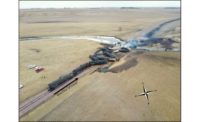From grain silos to tank cars

A confined space is defined as an area large enough for an employee to enter and perform work. It has limited or restricted means of entry or exit and is not designed for continuous human occupancy.
Some spaces present further hazards and have been designated permit-required confined spaces. Permit-required confined spaces have one or more of the following characteristics:
- They contain, or have a known potential to contain, hazardous atmospheric conditions.
- They contain material with engulfment potential.
- They are configured such that entrants could be trapped or asphyxiated by inwardly converging walls or floors which slope and taper to a smaller cross section.
- They present any other recognized serious safety or health hazards.
Open-topped water tanks
Work on open-topped water tanks, such as those used to supply municipalities with fresh water, is often performed from risers placed within the tanks or on catwalks located above. Regular maintenance involves priming, painting, refinishing and sandblasting and requires the use of potentially hazardous materials such as epoxies. It is essential to provide workers with adequate ventilation, oxygen sensors and appropriate PPE to protect from concentrated hazardous vapors and a lack of oxygen — despite the tank’s open top.
Sewer and underground pump stations
Recorded maintenance incidents include flooded chambers, toxic gas leaks, and oxygen-deficient atmospheres. These have resulted in drowning and asphyxiation due to oxygen deprivation and exposure to carbon monoxide and sewer gas. Newer self-priming sewer pumps help offset these incidents.
Wastewater holding tanks
Maintaining wastewater holding tanks may involve the use of sulfuric acid for drain cleaning. Toxic acid vapors plus possible methane gas produced by stored wastes create a significant confined-space entry hazard for both toxic chemical exposure and asphyxiation.
Degreasing tanks
Used in various industries to clean metal parts, degreasing tanks must occasionally be cleaned which can lead to the release of toxic vapors as workers discard or store the solvents used in the degreasing process. For this reason, entry to the tank should be attempted only after the confined space has been thoroughly ventilated.
Grain silos
Grain silos present several confined space entry challenges, including bridging, a condition where grain that is stored wet crusts at the silo’s surface, slowing grain flow. Workers sometimes walk on this surface to break up the crust, and many have fallen through and died from engulfment. In addition, flowing grain emptying through a silo’s bottom creates a surprising degree of force. A worker who has slipped into the grain flow just waist deep is at considerable risk of suffocation even when clutching a safety rope. Grain spoilage presents yet another worker confined-space hazard, as decomposition produces carbon dioxide that displaces oxygen, leading to suffocation.
Sawdust silos
Sawmills store sawdust as a fuel to generate steam which is then converted to electricity for mill use. The sweep auger advance mechanisms that move the sawdust from silos can become clogged during the removal process. Workers attempting to clear auger clogs can be subject to sawdust engulfment and death by asphyxiation.
Electric arc furnaces
Steel mills employ electric arc furnaces and turretmounted ladles to blend molten steel components using piped-in argon to aid in the blend. The turrets are driven by gears and motors housed below in confined service areas. Argon can leak into these small areas, displacing oxygen and creating a risk for oxygen deficiency. Fatal incidents have caused some mills to reroute argon piping away from these confined service areas.
Railroad tank car
Cleaning, repairing and refurbishing railroad tanks often involves interior sweeping, welding, cutting, scraping, buffing and abrasive blasting. These processes release hazardous residue including toxic chemicals, airborne insulation and dust. In addition, a cover gas such as nitrogen may have been used to prevent spoilage of food-related shipments, thereby displacing significant amounts of oxygen. The polyisocyanate foam used to insulate chlorine-carrying tank cars presents yet another hazard. It is a source of potential ignition, and the resulting smoke may expose workers to toxic substances.
Workers generally enter empty tank car confined spaces via top hatches. It is essential that railroad tank cars and other transport tanks are properly marked using warning signage and tags. Tank car interior confined spaces should be adequately ventilated as well as sampled and monitored for toxic gases, particulates, and oxygen deficiency.
References and sources:
• Permit-Required Confined Spaces, Final Rule; OSHA, 29 CFR Part 1910.146; Federal Register, 63:66018-66036 (1998, December 1).
• A Guide to Safety in Confined Spaces, (NIOSH Publication Number 87-113), July 1987.
• Working in Confined Spaces, (NIOSH Publication Number 80-106), December 1979.
• Safety Requirements for Confined Spaces, American National Standards Institute, Z117.1-1989, 1995 revision.
• NIOSH Fatality Assessment and Control Evaluation (FACE) Program: www.cdc.gov/niosh/face/ OSHA Safety and Health Topics; Confined Space: www. osha.gov/SLTC/confinedspaces/index.html\
Looking for a reprint of this article?
From high-res PDFs to custom plaques, order your copy today!






